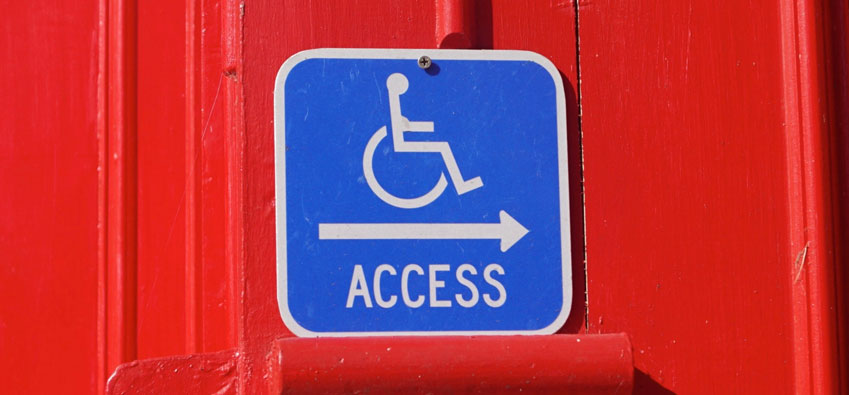What is this ADA Compliance stuff? Is my website in violation? Can I be sued?
We’re going to dig in and give you all the details. We’ll explain ADA so you can decide how to protect yourself, your company and why ADA Compliance is so important.
What is ADA?
The American with Disabilities Act (ADA) was established back in 1990. The law guarantees equal opportunity and equal access in a “place of public accommodation” to everyone.
Originally, ADA defined the terms “public accommodation” and “reasonable accommodation” as a physical location available to the public.
Public accommodations included public transportation, commercial buildings, lodging, recreation, dining, or anywhere that the people have access to.

The Federal government changed this meaning in 1998 when it introduced section 508. Section 508 required that government agency technology, including websites, meet accessibility standards.
However, even though the government required websites to meet ADA standards, they did not define any specific equal access requirement standards.
Consequently, since the government had failed to provide any actual standards to follow, the W3C did. The World Wide Consortium (W3C) started the Web Accessibility Initiative.
The Web Accessibility Initiative (WAI) published its guidelines in 1998 for website ADA compliance, Web Content Accessibility Guidelines (WCAG).
Their goal is to make accessibility and ADA website compliance a universal standard for web design and development.
In 2010 in the United States Department of Justice set standards that required businesses with an online presence to create an accessible website for people with disabilities.
In short, any user with a disability should have the same perceivable experience of any qualified individual without a disability.
Currently, As of 2018, the current WCAG 2.0 guidelines are the standards required to meet 508 and ADA Title III compliance.

Can I be sued for non-compliance?
<a id="sued"></a>The short answer is, absolutely yes.
To begin, section 508 regulations require government websites to maintain accessibility, not private businesses.
Nevertheless, attorneys have successfully filed thousands of lawsuits against private businesses by using this precedent.
Attorneys have taken Legal action against large companies such as Target, Netflix, Nike, CVS Pharmacy, Harvard University, and even Beyonce.
Small businesses are not immune. Predatory law firms are targeting an increasing number of small businesses, often looking for a quick payday.
Therefore, the threat of an expensive legal battle frequently forces Small business owners to settle out of court. The settlements for small businesses routinely run in the tens of thousands of dollars.
WARNINGS:
Common myth 1:
I don’t need to comply with ADA because I have less than 15 employees.
This part has confused a lot of people. ADA contains several Titles. The ADA Title I “less than 15 employees” rule is related to ADA employment laws. This does not have anything to do with websites.
On the other hand, ADA Title III rules are related to websites. Any publicly available website is subject to Title III ADA Compliance laws.
Common myth 2:
I don’t have a public store or location that customers can physically visit, so I am not subject to ADA.
Unfortunately, courts have ruled that websites should be considered “public”. Netflix tried unsuccessfully to argue that they did not have a physical location and should be exempt. They lost.
Are there other advantages to being ADA compliant?
There are significant advantages to being a compliant website, beyond just avoiding lawsuits.
Firstly, visually and otherwise impaired individuals are becoming more avid internet users as more websites become compliant.
Further, ADA compliant websites are cleaner and easier to read by search engines. Search engines give preference to websites that are easier for Google to understand.
To sum up, compliant websites create a win-win by getting more traffic, more clients, new clients, and better performance.
How do I know if my website is accessible?
You can use many tools to create a simple evaluation of your site. However, it is always best though to consult a professional for an in-depth audit.
In addition, a professional ADA developer will evaluate the issues, their priority, complexity, and possible solutions.

The World Wide Web Consortium has an extensive Web Accessibility Evaluation tools list.
What are the accessibility requirements that would cause my website to be non-compliant?
To begin with, the list of website content compliance guidelines is diverse and long. Fortunately, you can review simple issues relatively quickly just by looking at free reports.
Unfortunately, many technical ADA issues deal with physical and programmatic access to your web content. Moreover, most of the technical issues are difficult to diagnose without the proper tools and training.
The most basic success criteria for website compliance will include consideration of color contrast, contrast ratio, font size, keyboard functionality, and legibility.
For example, you can check your website’s ADA color contrast compliance here.
The most widely known issue relates to pictures without Alt Text. All of your photos or images should have descriptive text added to the website code to be recognizable to screen readers.
Similarly, pictures of text instead of actual text on a picture is another common issue. Pictures of text are not visible to visually impaired users, screen readers, or Google.
Another major requirement is that your site should be easily navigatable with the Tab and arrow keys using just the keyboard and not require a mouse.
Also, ADA requires video transcription for the hearing impaired. Audio descriptions may be necessary to describe videos to visually impaired users.
In addition to all this, there are many more compliance requirements related to code structure. Your website should have detailed and technical markup. Technical markup ensures that your site is handled correctly by screen readers and other accessibility tools.
How do I make my website ADA compliant?
Solutions for ADA compliance generally fall into one of three categories.
First, Manual ADA Repair
Experts in web accessibility update your website to achieve a high compliance level. New website costs typically can increase by an average of 40% to make them fully accessible.
Additionally, Ongoing maintenance is also required to ensure that compliance stays consistent despite updates and changes.
The cost to bring current sites with around 1000 pages in compliance is typically in the $15K per year range. Ongoing maintenance will be necessary to maintain compliance.
Second, Free ADA Software, Plugins, or Widgets
These solutions handle CSS adjustments for low visual impairments and epilepsy but only touch up to 25% of the WCAG requirements.
Again, you will need to hire someone to get your site initially up to compliance. After you have the widget in place, you should have your site re-examined on a monthly or quarterly schedule.
Finally, accessiBe
accessiBe is a fully automated audit and ongoing maintenance platform. accessiBe includes CSS adjustments for low visual impairments, epilepsy, color blindness, cognitive, and learning disabilities.
accessiBe includes 75% of the WCAG requirements. accessiBe features includee; assistive technology optimization, aria attributes, elemental structural roles, and provides alt tags for images using OCR and IRIS Ai technologies.
Our Suggestion
A professionally managed wite will always be the best option for an accessibility strategy. A managed site would include accessibility protocols and requirements for development, management, and updates.
On the other hand, accessiBe offers an excellent product for small to medium-size businesses in our opinion. If you are looking to improve your compliance, but cannot afford a fully managed Accessibility plan, accessiBe may be right for you.
Final Thoughts
To sum up, website accessibility and ADA compliance are critical for today’s businesses, large and small. The importance and risks of not having a compliant website are growing by the day.
You are likely losing customers if you’re website is not compliant.
Even worse, the threat of an ADA lawsuit does not appear to be going away anytime soon.
Get an ADA Evaluation
REACH OUT TO RHINO GROUP FOR AN ADA CHECKUP. LEARN HOW TO MAINTAIN DIGITAL ACCESSIBILITY MOVING FORWARD!
We have dealt with many ADA compliance issues. The momentum in the ADA industry is taking the internet by storm. we will continue to provide quality support to our clients in tackling this issue.
Please contact us today, or give us a call at 847-505-8000.


